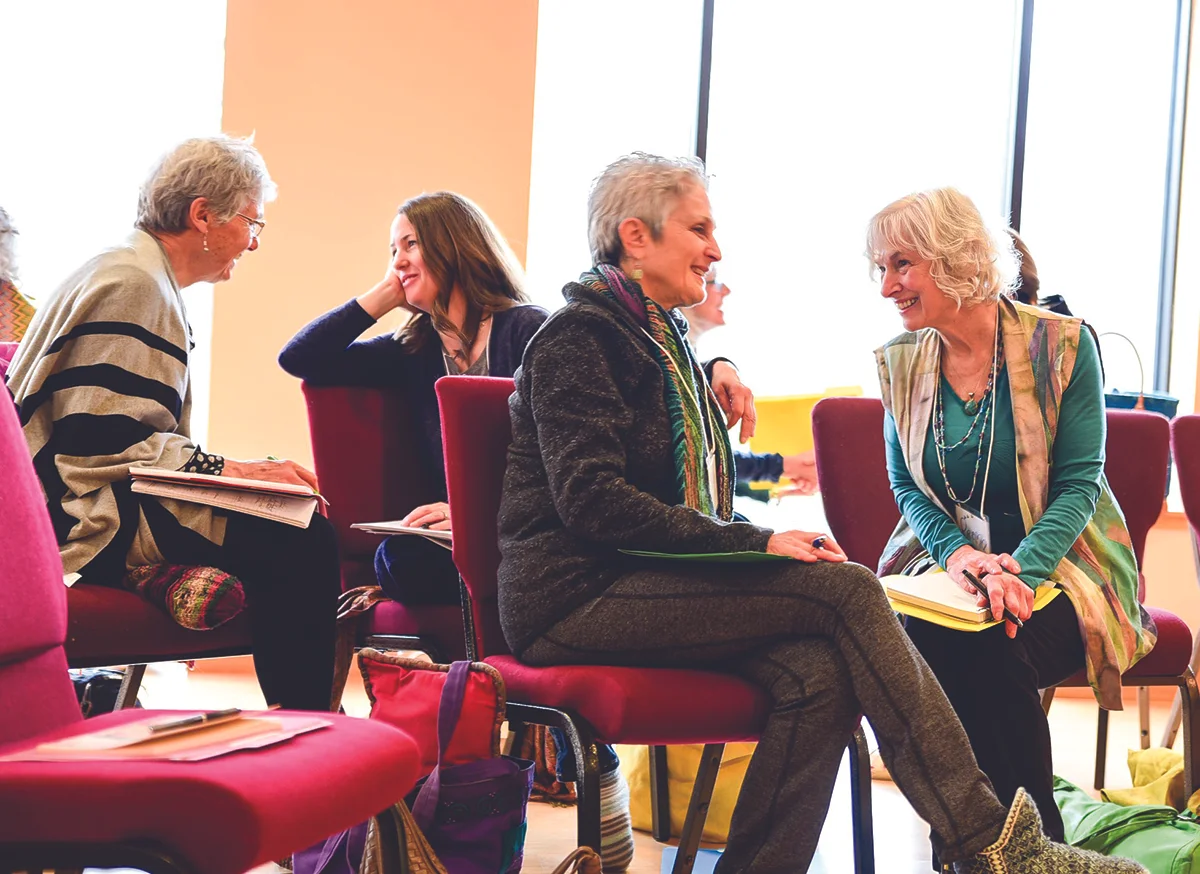By Carin Michaels
I tell everyone that my daughter went to the high school featured in the movie “Mean Girls,” and that it was true to its namesake, minus the caricatures. Back then, I didn’t know how to help my daughter navigate the turbulent social climate. That is, until I had a women’s circle at my house. She sat in a few times and the women loved her. Not once was my daughter marginalized. The women in our circle made space for her by listening, asking questions, and affirming that her goals were important. Fast forward to our new lives: my daughter is thriving at a university in Los Angeles with her own circle, and I have found one here in Ann Arbor. One of the most important lessons I’ve learned from being part of a women’s circle is that it is a safe and sacred space to come together with authenticity, and its regenerative properties sustain me.
Women gathering together for spiritual nourishment dates back for centuries. Anita Diamant, in her book The Red Tent, offers a glimpse into this piece of our forgotten history as the women in her story come together in huts or tents to menstruate or give birth and to bond. This practice, along with the ancient Jewish ritual of Rosh Chodesh—a monthly gathering each new moon for women to connect and learn—helped create and foster strong familial and social bonds and supported the psychological and physiological needs of women. Barbara Boyd Rust, PhD, the founder of my new tribe, A Place in the Circle, explained its workings. “The circle comes from various sorts of practices in women’s spiritual communities where the circle is the container, that we are all one part of the circle.” She also noted that women’s circles were strong locally in the 1970s as political action committees happening on campus, becoming the framework for equal rights and antiwar demonstrations.
A Place in the Circle is a safe and welcoming space for women healers, artists, and teachers to meet, share, and celebrate connection in our community. It’s essentially a day long retreat that slows down time by focusing on a specific theme. Three distinct generations of women come together to explore their paths of self-expression and service; whether you’re a novice or seasoned spiritual seeker, there is a place for you in this circle. Boyk Rust said, “Your place in the circle is self-determined. Are you a healer, artist, teacher? It’s about what’s in your soul, based on your calling, your essence, and not your job description.”
The first gathering in 2011 illustrated the need for a circle such as this one in our community; it brought 80 women together, many of whom sometimes felt isolated. Since then, Ann Arbor has continued to garner a wide range of practitioners of conscious living and holistic modalities, and the Circle has adapted to stay current with new ways of thinking, being, and healing. An upcoming facilitator, Julie Brigham, is an AmSAT certified teacher in the Alexander Technique. “I'm not from here,” she noted, sporting a crisp, British accent from New Castle, England. “I know people inside the Alexander Technique world, but as far as other techniques I wasn't connected.” She attended her first circle a few years ago. “Meeting other practitioners generated more work, yes, but I found out what they're about, and I said, ‘Oh, I didn't know there was someone who did that in town.’” As I continued to meet women in the Circle, I learned that they traded client sessions, shared referrals, provided technical support in their various modalities and became sisters.
Some would say that building a network is based upon the Law of Attraction, but in simple English, our work is experiential and we need our six senses to understand how another practitioner can help or relate to us; it’s not enough to just read their website. We cannot rely on two or three degrees of separation; we need to be intimately connected.
Whether a facilitator or a participant, women who attend A Place in the Circle speak to establishing connections. Stefanie Cohen, MA, RSME, is an ISMETA Registered Somatic Movement Educator who attended the very first circle in 2011. She reflected, “I had met at least a good handful of longstanding people who have either become practitioners of mine or I have become a teacher of theirs. I didn't even remember some of these connections until recently, so that’s a nice history.”
Cohen confused me at first by using the term “practitioner” interchangeably when referring to Circle attendees. I thought that this ordained arena was open to anyone with a self-determined predilection to being a healer, teacher, or artist whether or not they have formal training or credentials, so I asked, “As a writer, can I be considered an artist when you, as a bodyworker, facilitate the next Circle?” I also added that I meditate daily. She clarified, “When I say practitioners, I mean that we call it a practice, so those who engage in this meditative practice attend. People are welcome in at any stage of engagement. Nobody need have any formal background as a dancer or athlete.”
A true teacher, Cohen helped me understand that the key word to defining a spiritual practice is sustainment. “My work is source material, which may be for art, but also connects me to Spirit. I like to say, ‘It’s when I’m connected to everything and nothing at the same time.’” Her cutting edge vision seeps into your pores, a wellspring of vicarious sustenance. She helped me see that my practice merits inclusion in the Circle, and this was liberating.
Each Circle focuses on a central theme that serves as the framework from which we gather to connect, share, teach, and learn. Boyk Rust stated, “I think we have an endless supply of great facilitators in Ann Arbor, so to create days as we have been—bringing different facilitators, different themes, different possibilities together, and open it up for women to come, share, learn and connect—makes it a genuine women’s circle.” I prodded her to go deeper. My work in the Circle had been transformative. She chuckled, “Oh, right. I just assumed that. The work we do is transformative.”
Many practitioners who have attended the Circle speak to its positive effects. Kimberly Harrison, B.A., M.A., a sound healer and voice teacher, was a participant at her first circle when she met another sound healer who was the facilitator. After the Circle that day, they worked on each other, sharing their sound healing techniques and philosophies with one another. The other practitioner moved out of state soon afterward, and Harrison was recommended to take on her clients. To this day, the two remain friends. Harrison said, “That was an unexpected surprise.” Harrison also facilitated a sound healing circle thereafter, which was when I met her.
Harrison has a spark. She cares deeply and wants everyone to understand that we are all equal in her playing field, even though her training and voice are contenders for national recognition. She won awards for the Best Voice Lessons and Best Performing Arts Business from 2014 to 2017 in Santa Monica, CA, where she was living. Santa Monica is considered a hot spot for the Hollywood and Los Angeles crowd. She said, “It was magical. I worked with a lot of people who were afraid to sing for one reason or another. They may have negative fears of their voice because of what someone said in the past, or some judgment they have made themselves, or because our society at large has these specific ideas about who gets to sing and who doesn’t.”
Ardent about sound healing, Harrison stated, “It's really important we take our voices back. I want people to know that they can learn to sing. Our unaltered unique sound is so much richer than a sound from American Idol. It's really a one-dimensional way of looking at our voices. We need to help each other become more accepting as to who we are.”
Using a visual analogy, Boyk Rust spoke about the power of the Circle. “We once did a spiral dance in age order. The oldest of us was in her 80s, the youngest was maybe 30, and as we spiraled out into a circle, the youngest had an epiphany.” Boyk Rust was careful to protect confidentiality, but she shared what she could. “When the dance stopped, the youngest woman noticed the span of life that passed between her on both sides. Prior to coming that day to the Circle, the youngest woman was feeling like she didn't know what more to do with her life. She reached the pinnacle of her career, and she didn't have a clear trajectory for the future. All of a sudden, she looked around her and realized the embodiment of her future was right in front of her.”
Just by meeting the powerful trailblazers who make up our Circle, I’ve learned a lot more about language, artistry, and myself. The lessons I’ve learned from being part of a circle affirm my wisdom. As a mother, it’s helped me be a healer, teacher, and artist; as a practitioner, it allows me to sustain myself, my writing, and everything else in between. This vortex eases my Catch-22 existence, since its energy is transferrable, professionally, as well as personally. I invite you to my circle: it is a powerful tool, not only for networking, but also for conservation.
A Place in the Circle meets biannually. Join them for a transformative experience October 17, 2019 to share a scrumptious meal and explore the next topic, My Body: Vessel and Vehicle for my Life and Dreams. Presenters will include Stefanie Cohen and Julie Brigham. For more information on the Circle and the upcoming meetings, please visit their page at aplaceinthecircle.net.
Carin Michaels is a writer and playwright living in Ann Arbor.
































































































































































































To liken Book Suey to an average bookstore would be akin to calling Mary Shelley’s Frankenstein “the boy next door.” It’s missing all the other crucial pieces that make Book Suey a must-stop destination—sure, you can come in for a book, but you can also stop in and read a poem during open-mic night, attend a writing workshop, sell a physical copy of your writing, and more. Think of Book Suey as a bookstore with a side of DIY ethos, a pinch of mischief, and the kind of vibes that make you want to stay a while. Maybe even forever, as co-owners Cat Batsios and Elijah “Eli” Sparkman will explain.